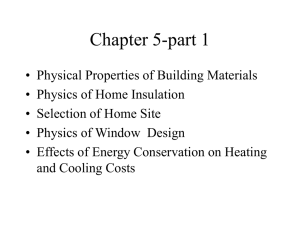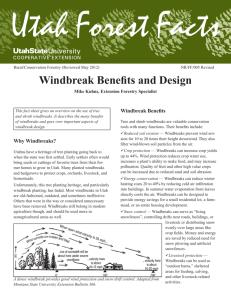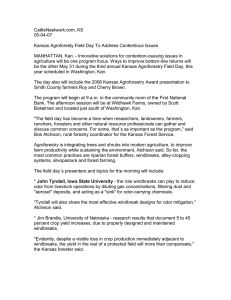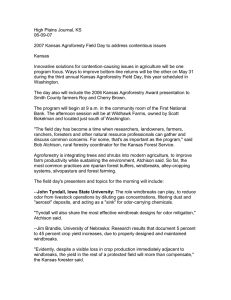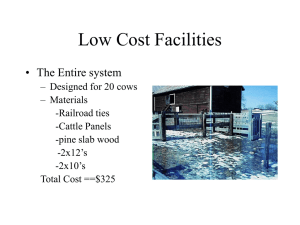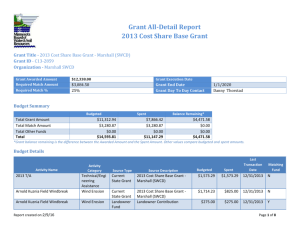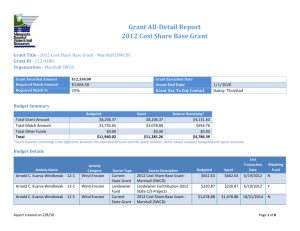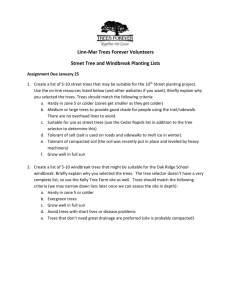Farmstead Windbreaks: Planning
advertisement
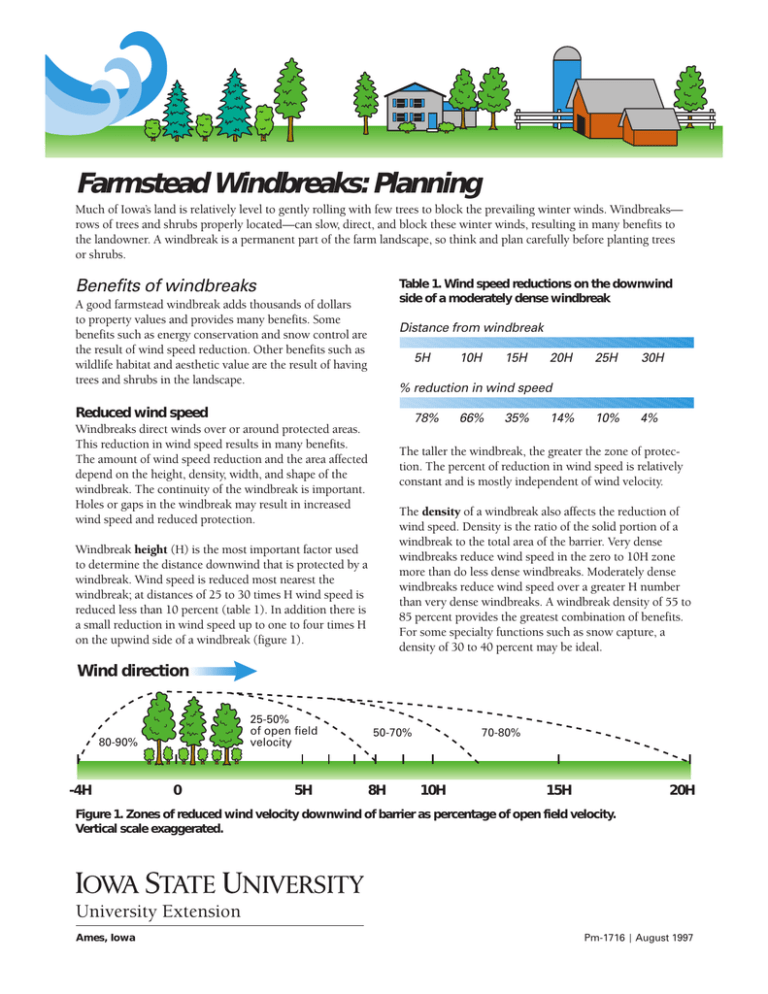
Farmstead Windbreaks: Planning Much of Iowa’s land is relatively level to gently rolling with few trees to block the prevailing winter winds. Windbreaks— rows of trees and shrubs properly located—can slow, direct, and block these winter winds, resulting in many benefits to the landowner. A windbreak is a permanent part of the farm landscape, so think and plan carefully before planting trees or shrubs. Benefits of windbreaks Table 1. Wind speed reductions on the downwind side of a moderately dense windbreak A good farmstead windbreak adds thousands of dollars to property values and provides many benefits. Some benefits such as energy conservation and snow control are the result of wind speed reduction. Other benefits such as wildlife habitat and aesthetic value are the result of having trees and shrubs in the landscape. Distance from windbreak 5H 10H 15H 20H 25H 30H 10% 4% % reduction in wind speed Reduced wind speed 78% Windbreaks direct winds over or around protected areas. This reduction in wind speed results in many benefits. The amount of wind speed reduction and the area affected depend on the height, density, width, and shape of the windbreak. The continuity of the windbreak is important. Holes or gaps in the windbreak may result in increased wind speed and reduced protection. 66% 35% 14% The taller the windbreak, the greater the zone of protection. The percent of reduction in wind speed is relatively constant and is mostly independent of wind velocity. The density of a windbreak also affects the reduction of wind speed. Density is the ratio of the solid portion of a windbreak to the total area of the barrier. Very dense windbreaks reduce wind speed in the zero to 10H zone more than do less dense windbreaks. Moderately dense windbreaks reduce wind speed over a greater H number than very dense windbreaks. A windbreak density of 55 to 85 percent provides the greatest combination of benefits. For some specialty functions such as snow capture, a density of 30 to 40 percent may be ideal. Windbreak height (H) is the most important factor used to determine the distance downwind that is protected by a windbreak. Wind speed is reduced most nearest the windbreak; at distances of 25 to 30 times H wind speed is reduced less than 10 percent (table 1). In addition there is a small reduction in wind speed up to one to four times H on the upwind side of a windbreak (figure 1). Wind direction 25-50% of open field velocity 80-90% -4H 0 5H 50-70% 8H 70-80% 10H 15H 20H Figure 1. Zones of reduced wind velocity downwind of barrier as percentage of open field velocity. Vertical scale exaggerated. University Extension Ames, Iowa Pm-1716 August 1997 Windbreak width contributes increased protection; it allows increased density by adding additional rows. Narrow windbreaks of high density may be as effective as wider windbreaks with equal density. However, narrow windbreaks provide no safety factor because a single dead tree may leave a gap in the windbreak. Windbreak cross-sectional shape provides some modest difference in protection. Vertical-side windbreaks (tallest trees on the upwind side) provide a modest increase in area protected. Windbreaks arranged in a stair-step pattern (shortest tree on the upwind and tallest on the downwind) provide greater efficiency in lifting winds and less dumping and swirling in the protected zone. If beauty and aesthetics are important, establish the landowner’s choice on the inside row and use the remaining rows to establish the desired shape. A windbreak will be most effective when placed at right angles to the winds. In Iowa, winter protection from the normally prevailing northwest winds is optimal. Single direction windbreaks provide less protection Protection than double Zone direction windbreaks N provide (figure 2). Completely surrounding a farmstead with a dense windbreak Protection Zone will reduce positive effects of wind movement during the summer months. Protection Zone Figure 2. Multiple leg or extended windbreaks provide greater protection than single leg windbreaks. Energy conservation Well designed and placed windbreaks can reduce energy costs by as much as 20 to 40 percent. The type of home, energy efficiency, efficiency of home heating unit, and other factors will determine the individual savings. Any heated building or confinement space will benefit from the reduced chill factor resulting from reduced wind speeds. This represents the greatest potential for energy savings from a windbreak in Iowa. In the summer, if the home is exposed to very hot winds, a windbreak may reduce cooling costs by reducing the infiltration of hot air. This benefit must be weighed against the positive effects of some air movement and flow through the farmstead during the warmer months. Snow control Windbreaks can be used to control or store snow, keeping it away from critical areas in the farmstead. Single rows of shrubs or trees can function as snow fences, trapping snow away from protected areas. Living snow fences should be planted 100 to 150 feet away from roads; they should be extended beyond the protected area. Windbreaks become more functional for snow stopping and storage as rows are added beyond the minimum. To trap additional snow, establish a living snow fence 50 to 150 feet away from the windbreak on the upwind side. Always check with local zoning or with the Natural Resources Conservation Service (NRCS) before establishing trees on the west or north side of roads. Improved working environment Windbreaks improve the work environment of the farmstead. Wind speed reduction results in a lower windchill index and makes working in the outdoor environment more pleasant. Windbreaks also may reduce noise and filter dust from fields or roads. Wildlife habitat Windbreaks provide needed wildlife habitat in Iowa for feeding, shelter, nesting, and breeding. Windbreaks can be improved for wildlife habitat by increasing their size and selecting species most beneficial to wildlife. Contact your Iowa Department of Natural Resources wildlife biologist or Iowa State University Extension’s wildlife specialist for additional assistance. Livestock protection Design considerations Livestock protected by a windbreak will use more of their feed for weight gain and less to maintain body heat. Windbreaks also can provide protection for feedlots, pastures, calving areas, and confinement buildings. Primary windbreaks around farmsteads with secondary windbreaks around livestock facilities may provide optimum benefits (figure 3). Windbreaks for the home or farmstead should be carefully planned. The windbreak becomes an integral part of the site for at least 50 years. A well planned windbreak will enhance the property’s value throughout the years. The location and layout should ensure that the windbreak is a benefit and not a hazard. North and west protection For the greatest protection, locate the windbreak on the north and west sides of the farmstead. In Iowa it usually is not a good idea to totally enclose the farmstead with a windbreak because of reduced air flow during the summer months. The establishment of landscape plants on the south and east is acceptable. N Barn House Machine Shed Extend the windbreak 100 feet south and east beyond the last main protected structure. This additional windbreak avoids sweeping winds on the farmstead corners. Also, snowdrifts which form around the ends of the windbreak will be beyond the farmstead corners. Distance to protected site Secondary Windbreak Feed Lot Figure 3. Because windbreak protection is limited by tree height, secondary windbreaks may provide additional protection to large farmsteads. The inside row of narrow windbreaks should be at least 75 feet from buildings or structures or the outside row should be 100 to 150 feet away from the protected zone (figure 4). Significant snow drifting can occur in the first two heights of a narrow windbreak. Wider windbreaks will result in more snow accumulating inside the windbreak and less drifting through. If snow control is a critical issue, consider adding a living snow fence north and west of the windbreak or making the windbreak wider. If snow dump or Tree products In some cases, windbreaks may provide wood products including biomass, posts, poles, lumber, and firewood. On some sites, the production of high-value hardwoods (walnut, oak, ash, and maple) may be combined with windbreak benefits. Establishing gardens or fruit and nut trees on the downwind side of a windbreak may provide additional benefits. 75' 100' - 150' Aesthetics and property value Windbreaks provide beauty and aesthetics to the farmstead. A well designed and maintained windbreak will greatly enhance the value of the farmstead and contribute to the pride of ownership of the property. Figure 4. Narrow windbreaks must be 75’ or more from protected areas. Wider windbreaks can be located closer to the protected site. accumulation is not a problem, the distance from the windbreak to the protected site may be reduced, resulting in greater protection. windbreak. The optimum way to increase windbreak density throughout its life is by adding additional rows to the windbreak. Density An alternative within-row spacing scheme is to plant trees at one-half the recommended spacing and plan to thin and remove every other tree before competition results in loss of branches. The minimum windbreak recommended in Iowa is three rows. The standard arrangement is a row of shrubs with two rows of conifers. The function, durability, and longevity of a windbreak improves with each additional row up to 10 rows. Each additional row beyond 10 contributes little to increasing the wind-slowing function of the windbreak but may enhance other values such as wildlife habitat. Occasionally Iowa soils prohibit the use of conifers in the windbreak because of excessive wetness or high soil pH. At least five rows of deciduous trees are required to approach the effectiveness of a windbreak consisting of a row of shrubs and two rows of conifers, and up to 15 to 20 rows will improve the effectiveness of the windbreak. The original farmstead groves consisting of one to five acres of trees on the north and west side of the farmstead functioned well as windbreaks and provided wood products and wildlife habitat. Farmstead Windbreaks: Establishment, Care, and Maintenance, (Iowa State University Extension publication Pm1717) provides information on species selection, planting, and the care and maintenance of windbreaks in Iowa. Additional technical information is available from your ISU Extension county office, or Iowa DNR district foresters or wildlife biologists. For on-site technical assistance and potential cost-share assistance, contact your county NRCS office. Spacing No single recommendation on row and tree spacing will satisfy all requirements concerning tree culture or windbreak benefits. Close spacing may provide some wind protection earlier, but wide spacing enables trees to retain lower branches longer and may result in a taller windbreak because of less competition between trees. If possible, space all rows 20 feet apart including shrub and hardwood trees. Wide spacing will reduce competition between rows, and result in windbreaks that retain lower foliage longer. In addition, the wider spacing allows for more snow storage inside the windbreak. If space is limited, the spacing between the shrub row and conifer trees can be reduced to 16 feet. Rows of deciduous trees should not be spaced closer than 14 feet. Within-row spacing will vary with species used and landowner objectives. Large conifers should be planted 14 to 25 feet apart; small conifers, 8 to 16 feet apart; deciduous trees, 8 to 20 feet apart; and shrubs, 3 to 13 feet apart depending on species. Narrow spacing between trees within a row will result in short-term increased density of the windbreak; the increased competition will result in self-pruning and competition, creating a less dense Prepared by Paul Wray, extension forester; Laura Sternweis, extension communication specialist; and Jane Lenahan, graphic designer. File: Forestry 5 And justice for all The Iowa Cooperative Extension Service’s programs and policies are consistent with pertinent federal and state laws and regulations on nondiscrimination. Many materials can be made available in alternative formats for ADA clients. Issued in furtherance of Cooperative Extension work, Acts of May 8 and June 30, 1914, in cooperation with the U.S. Department of Agriculture. Stanley R. Johnson, director, Cooperative Extension Service, Iowa State University of Science and Technology, Ames, Iowa.
